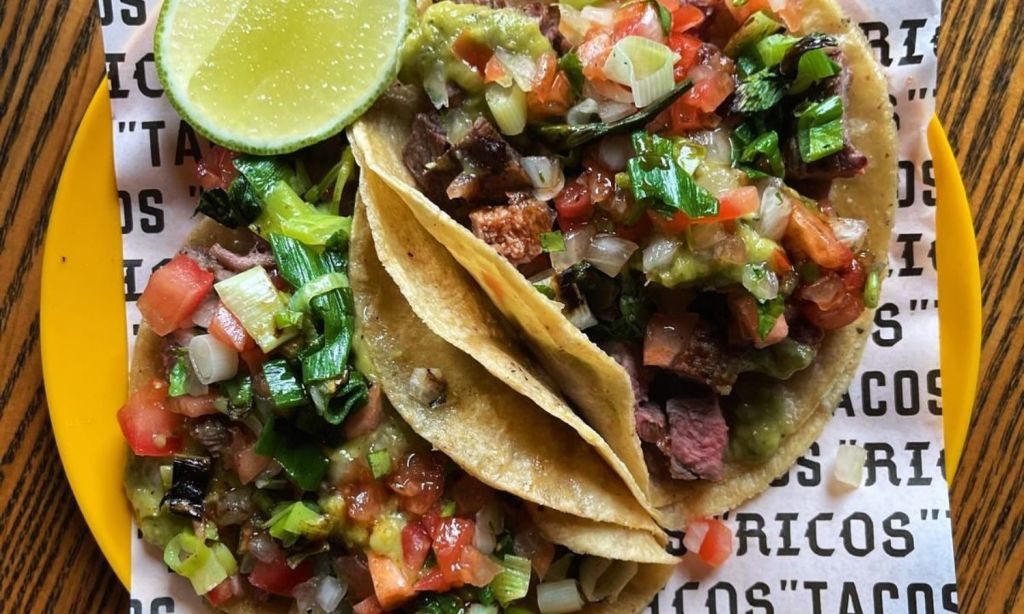Toby Wilson knows good Mexican food. He’s travelled through Mexico countless times, led the kitchen at Sydney taco eateries Ghostboy Cantina, Bad Hombres and Taco King and now runs a food truck-turned-permanent takeover of The Norfolk Hotel, Ricos Tacos.
He’s one of the best people to ask about Mexican cuisine in Australia — where it is now and where it will head. Or rather where it should head so we’re truly embracing it, cooking and eating it more like it’s done in Mexico.
“In Sydney, at least traditionally, we have had a lot more American Mexican food than Mexican Mexican food,” says Wilson who along with his role as chef-owner of Ricos Tacos is an advocate for Australian Avocados.
“In Mexico City and south of the [US] border, you’re not seeing a lot of burritos, nachos, that kind of thing. You do see it a little bit in northern Mexico. But it’s [Mexican food we eat in Australia] still pretty different from what you get in Mexico.”
In Mexico many burritos are cheese, beans and salsa — that’s it. In Australia, Wilson says, some burritos have 65 ingredients including guacamole, fries and slaws. The original nachos were corn chips, sliced jalapenos and shredded cheese, heated. The supreme nachos on many an Australian pub menu was an American invention.
According to American Mexican restaurant Nacho Hippo, nachos were invented in 1943 when Mexican chef Igancio Anaya took pity on a group of US military wives who spent the day shopping together and couldn’t find a restaurant open for dinner. Anaya cooked them a dish with whatever was left in his kitchen.
He sliced and fried tortilla chips, sliced jalapenos, covered it all in shredded cheese and then put the dish in the oven for a few minutes. Nachos were born. The supreme version offered at most Australian Mexican restaurants falls under the category of Tex-Mex. Most Australian Mexican restaurants offer Tex-Mex menus.
“Tex-Mex cuisine leans on yellow cheese, beef, canned tomatoes and flour tortillas,” writes American restaurant Alicia’s Mexican Grille. “In contrast, authentic Mexican cuisine emphasises fresh, locally sourced ingredients such as corn, diverse chilies and Indigenous vegetables, capturing the essence of regional flavours.”
The current lack of authentic Mexican cuisine in Australia could be in part because we don’t have much of a Mexican-born population here. A 2021 Australian Bureau of Statistics census found 6,845 Mexican-born people in Australia. This is compared to 927,490 British-born, 46,720 Brazilian-born and 36,019 French-born in that same year.
“The first ever Mexican recorded in Australia was a male living in Tasmania in 1881,” reports Cultural Atlas. “The Mexican-born population numbered fewer than a hundred people throughout the first half of the 20th century.”
The 21st century saw a significant jump in Mexican migration to Australia, with 2,055 arrivals recorded between 2000 and 2010. In 2011, the Mexican-born population grew to 3,255. Despite the growth, the Mexican-born population is still a relatively small migrant community in Australia.
Ricos Tacos and other newer Mexican restaurants La Prima and Gitano have put Sydney on the path to more authentic Mexican food. They offer more authentic menus. Gitano’s general manager, Francisco Rosales, says what Australians knew to be Mexican food was limited to Tex-Mex.
“Through the years, the exposure of traditional flavours like ceviche, street food-style tacos and original agave started captivating Sydney foodies,” Rosales says.
A few months ago, Wilson told me: “The availability of ingredients like fried chillies, masa, fresh tortillas and tomatillos is much greater now than when I opened my first taco joint eight years ago.”
So where does Wilson think Australia’s Mexican food is heading now? Will we continue down the route of Tex-Mex or veer into more authentic Mexican? Wilson predicts the latter. He says Australia’s Mexican dining scene is already starting to diversify.
“I’d love to see a point where there’s a taqueria [taco stand] that just does carne asada [grilled and sliced beef], one that just does fish tacos, one that just does al pastor [spit-grilled slices of pork],” he says. “That’s where I see the room to grow and for people to get good at a single thing instead of the jack of all trades we’ve had traditionally.”
Wilson says there are taquerias in Mexico with just two tacos: prawn or fish. One of his favourite places to eat in Tijuana, Mexico is a carne asada specialty taqueria. It has six things on the menu — all beef tacos, just different cuts including skirt steak, rump and sirloin. “That’s the menu,” he says. “All the tacos are effectively the same.”
While this level of specialisation might seem risky in Sydney’s diverse food scene, it’s a testament to the authenticity of Mexican cuisine. Restaurant coach Monte Silva recently sang the praises of a hyper-focused menu, saying they could led to efficiency and consistency, loyalty, profitability and consistency.
However, given the current economic climate and the recent closures of high-profile restaurants, it’s understandable why many entrepreneurs are hesitant to take such a risk. As the market continues to evolve, we can only hope that Sydney will eventually embrace the simplicity and authenticity of Mexican street food.
Related: Lennox Hastie’s Guide to One of the World’s Most Awarded Gastronomical Cities
Related: Australia’s Saying Oui Oui to French Restaurants Again
Read more stories from The Latch and subscribe to our email newsletter.

